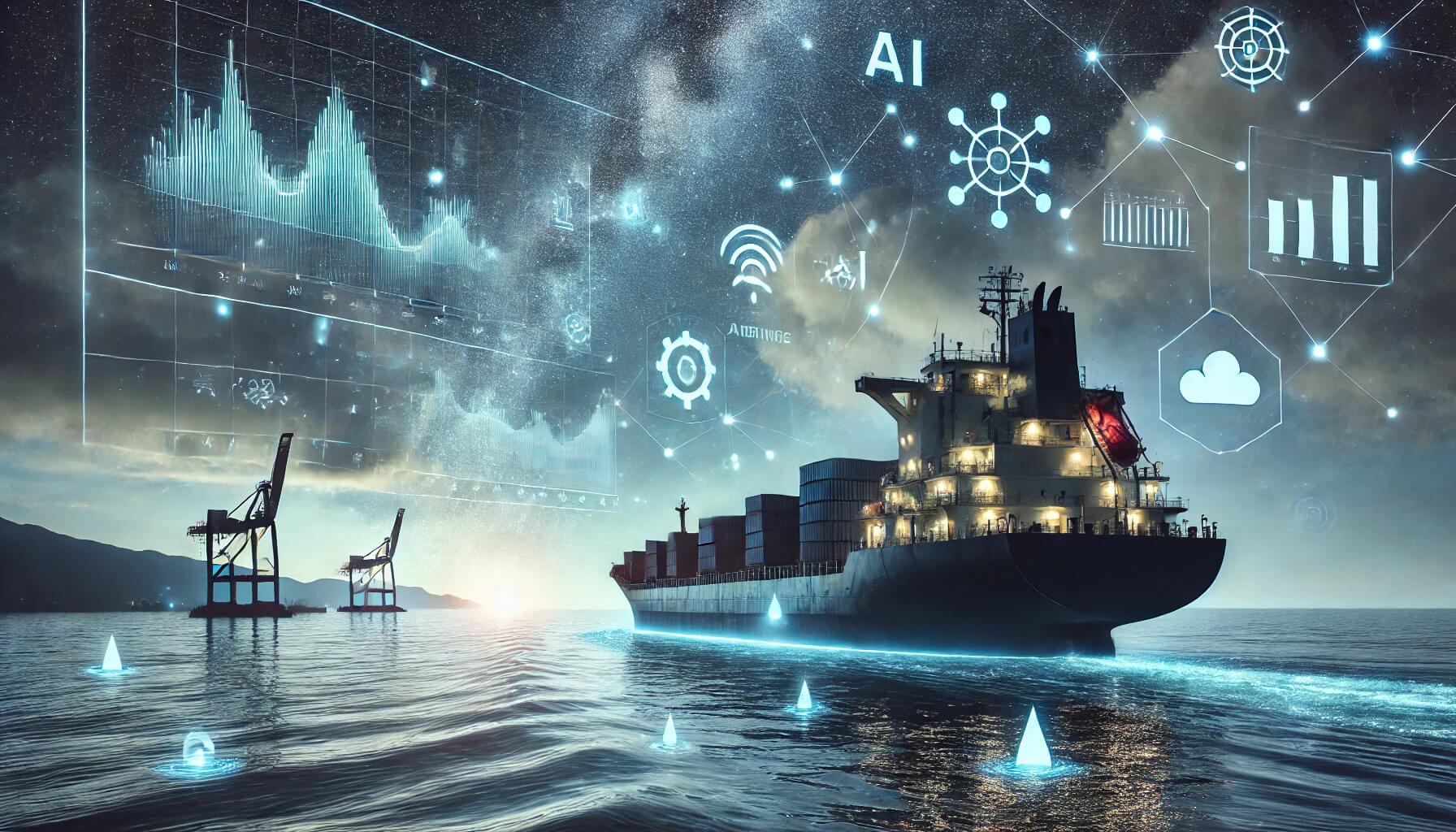Setting Sail With AI
In the dead of night, aboard the cargo ship Voyager, a subtle vibration begins in the engine room—a precursor to a potential disaster. But this night is different.
Before the situation escalates, a sophisticated AI system that analyses the engine’s performance data detects the anomaly. It alerts the engineering team, recommending preemptive maintenance that averts a costly failure and saves the ship from delayed voyages.
This scenario, once a futuristic dream, is today’s reality thanks to AI-driven predictive maintenance in the maritime industry. By transforming data into predictive insights, AI ensures that the only waves ships have to contend with are those on the sea.
Deep Dive into AI-driven Predictive Maintenance
Predictive maintenance, powered by artificial intelligence, is revolutionising the maritime industry by turning data into preventive action. This technology is not just about avoiding breakdowns; it’s about redefining how ships operate, ensuring they are safer, more efficient, and more reliable.
- Understanding Technology
At its core, AI-driven predictive maintenance utilises a complex array of sensors integrated throughout the ship. These sensors continuously collect data on operational parameters, such as engine RPMs, oil quality, and exhaust temperatures.
Advanced algorithms analyse this data in real-time, comparing it against historical patterns and predictive models to identify any signs of potential failures.
- From Insight to Action
When an anomaly is detected, the system doesn’t just flag it; it provides a detailed diagnostic report and recommends specific maintenance actions.
For instance, if a high vibration level is detected in the drive shaft, the AI might suggest inspecting the alignment and tightening any loose components, well before the issue leads to a failure.
- Case Example
Consider a scenario where the AI system on a cargo ship en route from Rotterdam to Singapore detected a slight but unusual increase in the main engine’s fuel consumption.
By analysing this data in conjunction with recent maintenance logs and performance metrics, the AI identified a developing issue with one of the fuel injectors. Maintenance crews at the next port of call were prepped with the right parts and tools, allowing them to fix the problem swiftly, avoiding a potential engine shutdown mid-ocean.
Integrating AI into the Maritime Workflow
The implementation of AI predictive maintenance systems within maritime operations isn’t just a plug-and-play solution; it requires thoughtful integration into existing technological and human workflows.
- Upgrading for AI Compatibility
Modern ships are marvels of engineering, but older vessels often require significant upgrades to their monitoring systems before they can fully leverage AI. This process involves not only installing new sensors but also upgrading network systems to handle vast amounts of data and ensuring robust cybersecurity measures are in place.
- Training for Transformation
As critical as the technology itself is the need for crew training. Effective integration of AI predictive maintenance means training crew members not only on how to interpret AI alerts but also on how to seamlessly incorporate this new technology into their daily operations.
Tailored training programmes are developed, combining virtual simulations and real-world scenarios, to ensure that all personnel are proficient and comfortable with the new systems.
- Operational Impact
The shift to AI-driven maintenance protocols significantly alters daily operations. Maintenance schedules become more dynamic and less intrusive, with repairs being conducted based on predictive insights rather than routine schedules or, worse, emergency reactions.
This shift not only enhances operational efficiency but also improves the overall safety of maritime travel.
Economic Advantages and Cost Efficiency
The financial implications of integrating AI-driven predictive maintenance are profound, offering significant cost savings and economic benefits that extend beyond the immediate avoidance of machinery failures.
- Reducing Operational Costs
AI predictive maintenance optimises the use of resources by ensuring that maintenance is only performed when necessary. This approach reduces unnecessary maintenance activities, which not only saves on direct costs, such as labour and parts but also minimizes downtime, keeping ships on their routes and operational.
- Lifecycle Extension of Vessel Components
By maintaining equipment proactively, AI helps extend the life of critical components. This is particularly important in maritime operations where replacement costs are high and procurement can often be logistically complex.
Enhanced longevity of parts leads to a decrease in the frequency and severity of capital expenditures over time.
- Insurance and Compliance Cost Reduction
Efficient maintenance routines driven by AI insights can lead to lower insurance premiums as insurers recognise the reduced risk of failures and accidents. Additionally, compliance with international maritime safety regulations is streamlined, avoiding fines and penalties that can accrue from non-compliance.
Navigating Environmental Sustainability
AI-driven predictive maintenance also plays a crucial role in promoting environmental sustainability within the maritime industry. As environmental regulations become stricter and public scrutiny of maritime impacts increases, leveraging AI for maintenance can provide significant ecological benefits.
- Reducing Emissions
Well-maintained engines and systems operate more efficiently and, consequently, emit fewer pollutants. AI’s ability to ensure optimal operation of machinery contributes directly to reducing the carbon footprint of maritime operations.
- Preventing Spills and Environmental Hazards
By preventing equipment failures, AI also minimizes the risk of accidents that could lead to oil spills or other environmental disasters. This proactive approach not only protects the marine ecosystem but also helps shipping companies adhere to environmental standards and avoid costly cleanup operations.
Fostering a Culture of Innovation
The shift to AI-driven predictive maintenance reflects a broader transformation within the maritime industry towards embracing technological innovation and digital transformation.
- Encouraging Technological Adoption
The success of AI in maintenance can encourage further adoption of digital technologies across other areas of maritime operations, such as navigation, cargo handling, and crew management. This creates a virtuous cycle of innovation and improvement.
- Skilling and Reskilling the Workforce
Integrating AI requires a shift in skills for the maritime workforce. As routine tasks are automated, the focus shifts to more strategic and analytical roles. Training programmes and continuous learning initiatives become crucial, aligning crew competencies with new technological realities.
- Strategic Partnerships and Collaborations
To effectively implement and leverage AI, maritime companies are increasingly partnering with tech firms, startups, and academic institutions. These collaborations not only enhance technological capabilities but also foster an ecosystem of innovation that can propel the entire industry forward.
Steering Towards a Predictive Future
AI-driven predictive maintenance is not just a technological upgrade; it’s a strategic revolution that is reshaping the maritime industry. This innovative approach enhances safety, boosts operational efficiency, reduces costs, and supports environmental sustainability.
By anticipating maintenance needs before they become critical issues, AI allows maritime companies to navigate the challenging waters of modern shipping with greater confidence and control.
Embrace AI to Navigate the Future
Maritime industry leaders are at a pivotal juncture. The choice to integrate AI-driven predictive maintenance is more than a technical decision—it’s a commitment to future-proofing operations and leading the charge in a competitive, rapidly evolving global landscape.
- Invest in AI Technology
Commit resources to adopt and integrate AI systems. The initial investment in AI predictive maintenance technology promises substantial returns in terms of reduced downtime, lower maintenance costs, and extended equipment lifespans.
- Partner With AI Experts
Collaborate with technology providers who specialise in AI and predictive maintenance. These partnerships can provide access to cutting-edge technologies and expertise that can accelerate the adoption and customization of AI solutions for specific maritime needs.
- Cultivate a Culture of Innovation
Encourage a company-wide culture that embraces change and innovation. Provide training and development opportunities that prepare your workforce for a future where AI plays a central role in day-to-day operations.
- Monitor, Measure, and Refine
Implement monitoring systems to track the performance of AI-driven maintenance initiatives. Use this data to continually refine practises, ensuring that AI systems are optimised to meet the evolving demands of maritime operations.
Propel Your Fleet into the AI Era with MetaOPT
Discover how MetaOPT can streamline your maritime operations with optimised AI-driven strategies. Our platform offers tailored solutions that enhance predictive maintenance capabilities, ensuring your fleet operates at peak efficiency. Visit our website to learn more and join the ranks of industry leaders who are charting a course for a smarter, safer, and more sustainable future.
FAQs
- How Does AI Predict Maintenance Needs on Ships?
AI uses data from onboard sensors to analyse patterns and predict potential failures. Machine learning models compare real-time data with historical performance to identify anomalies that could indicate impending equipment issues.
- What Are the Initial Steps to Implement AI in Maritime Operations?
Start with a pilot project focusing on a specific vessel or component. Ensure the necessary sensor and data infrastructure is in place, and partner with an AI solution provider to integrate predictive maintenance systems effectively.
- Can Ai-driven Maintenance Integrate With Older Ships?
Yes, AI-driven maintenance can be adapted to older vessels through retrofitting with modern sensors and upgrading existing systems to support AI technology. It requires careful planning and expertise to ensure compatibility and effectiveness.
- What Are the Risks Associated With AI in Predictive Maintenance?
While AI significantly enhances maintenance strategies, it relies heavily on data quality and system integrity. Poor data or system failures can lead to inaccurate predictions. Ongoing monitoring and maintenance of AI systems themselves are crucial to mitigate these risks.







No comment yet, add your voice below!